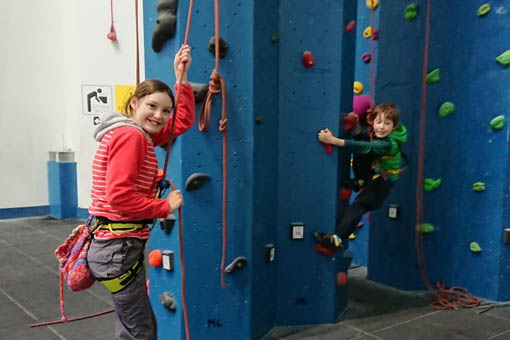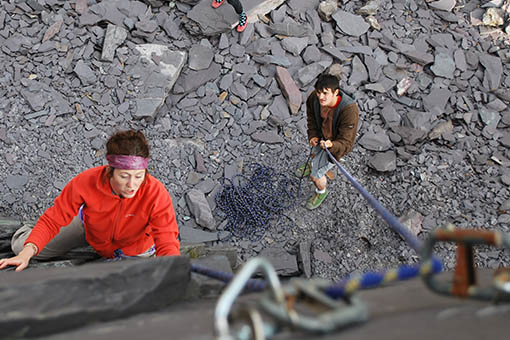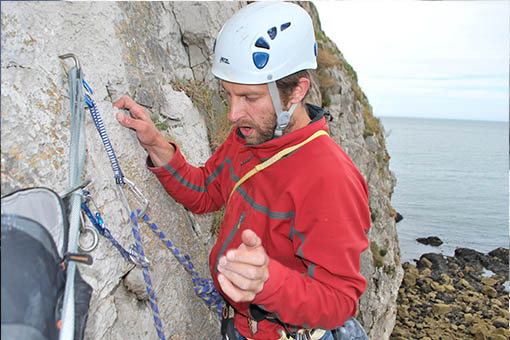Learn to Lead Sport Climbs
Coming Soon!
Please note, we are in the process of updating our website during the quiet winter period. During this time, some of the activities may become unavailable on the website. If you would like to discuss an activity then please drop us a message.
What will I Learn?
The list below explains the main learning objectives for this Lead Climbing course.
Avoiding injury
 [ Learn More... ]
[ Learn More... ]

The risks in climbing are numerous and each climbing discipline has its own hazards. Falling is the obvious risk, but you will also learn about other hazards relevant to the course. This could be warming up the muscles effectively, keeping out of the path of falling rocks, or prevent carabiners from being cross-loaded.
[ Hide ]Belaying
 [ Learn More... ]
[ Learn More... ]

Belaying is the act of holding a rope for a climbing partner. So that a climber doesn't hit the ground when they fall, they attach themselves to a rope. When they fall, they fall onto the rope and the rope takes their weight. Climbing is done in pairs as there needs to be somebody at the opposite end of the rope to keep hold of it. The person holding the rope is known as the belayer.
Rather than holding the rope directly, the belayer uses a belay device attached to their climbing harness to add friction and make it easier to hold the rope. A belay device makes it possible to hold the weight of a falling climber.
There are many types of belay devices available. Some are specific to different types of climbing, some accommodate one rope, some are intended for use with two ropes, and there are many specialist devices available. Knowing which one to use, and how to use it correctly, in any given situation is fundamental to climbing safely.
[ Hide ]Bolts / Bolt Types
 [ Learn More... ]
[ Learn More... ]

Bolts are fixed anchors which have been drilled and fixed into the rock. There are many types of bolts use in climbing, some are bolted in, some are glued in, and it's important to recognise the different types and be able to assess their condition. Bolts can come loose over time, they can rust, and sometimes they were not fixed properly to begin with.
[ Hide ]Bottom Roping
 [ Learn More... ]
[ Learn More... ]

Bottom-Roping is often confused with Top-Roping, so much so that the two terms have almost become interchangeable. Bottom-Roping relates to a situation whereby the person holding the rope is stood on the ground. The rope travels from their hands to the top of the cliff. Here it passes through an anchor and down to the climber. The advantage of bottom roping is that the climber always has the rope above them. This means that if they fall off the cliff, they are instantly caught by the rope. Climbers will often use bottom-roping when they are practicing a difficult climb. As the rope instantly catches them, it means that they don't have to re-climb a difficult section to get back to where they fell off. Bottom-roping is also used for novice climbers who have not prepared themselves for the mental aspect of taking large falls. Finally, bottom-roping is an excellent way to develop new skills. As the fear of falling is removed, the mind is relaxed and more open to new learning.
[ Hide ]Communication
 [ Learn More... ]
[ Learn More... ]

Good communication is imperative when climbing as a miscommunication could prove fatal. The biggest risk is usually the person on the ground letting go of the rope when the climber is attempting a difficult section. For example, a climber psychologically preparing themselves by saying "let's go" could easily be misinterpreted by their partner as "let go". On this course you will learn a set of standardised communication phrases which are intended to avoid such scenarios.
[ Hide ]Conservation
 [ Learn More... ]
[ Learn More... ]

At Climb Wales we take conservation seriously and this is embedded in all of the climbing and mountaineering courses that we offer. One of the many great things about climbing is interaction with nature. During the course we will look at how to minimise impact and ensure that future generations will be able to enjoy the same luxuries as we do.
[ Hide ]Equipment
 [ Learn More... ]
[ Learn More... ]

During the course you will learn to use a variety of climbing equipment. There are some aspects of equipment which are universal to all disciplines of climbing, such as climbing shoes, harness, helmet, ropes, belay devices and carabiners. Some items are specific to a particular discipline though and won't be the focus of other climbing courses, for example, during our multipitch climbing courses we will look at twin and half ropes but it's unlikely that these will be the focus of any of our other courses. On the sea cliff climbing course you will learn to use jumars and prusiks. And on the single pitch trad climbing course you will learn to place nuts, cams and hexes.
[ Hide ]Ethics
 [ Learn More... ]
[ Learn More... ]

Ethics has played an incredibly important part in shaping UK climbing, perhaps more so than in any other country. During this course you will learn about ethics in climbing and how it impacts what we do.
[ Hide ]Guidebooks
 [ Learn More... ]
[ Learn More... ]

As part of this climbing course you will learn how to read guidebooks, understand climbing grades, and find routes which are suited to your climbing abilities.
[ Hide ]Jargon
 [ Learn More... ]
[ Learn More... ]

"I've got no friends and my nuts are too small" is a phrase that many climbers have found themselves shouting down to their climbing partners. Snatch the Gaston, Undercling the flatty, Flag into an Egyptian, Dyno to the Crimper, Mantle on the Sloper and get ready to Dog the Flash... By the end of this course you will speak climbing lingo with the best of them.
[ Hide ]Knots
 [ Learn More... ]
[ Learn More... ]

Knots are an integral part of climbing and an extremely important link in a chain intended to keep us alive. For sport climbing the most important knot is the figure-eight, for multipitch and trad we extend the use of knots further with clove and Italian hitches, prusiks, bowlines and more. As part of this climbing course you will learn to tie and inspect knots appropriate to the discipline of climbing and how to ensure their safety.
[ Hide ]Leading
 [ Learn More... ]
[ Learn More... ]

For some, lead climbing is climbing. That is to say that lead climbing is the pure essence of climbing. You can arrive at a climber wall and find that some kind person has already left a rope hanging from the ceiling. You tie into one end and your belay partner takes the other. In this scenario you can fall off the wall safe int he knowledge that you have a rope above you. But what happens when you climb outdoors and there is no kind person to set up a rope for you? In this instance you have to lead climb, that is, to climb whilst trailing the rope below you. As you climb you clip the rope into runners (pieces of protection), in sport climbing this will be a purpose-built bolt which might be drilled and glued into the rock, in traditional climbing you will have to create your own protection using the natural features of the rock. In the event of a fall, you no longer have the rope to catch you immediately, and instead will fall part your last runner and keep falling until the rope becomes taut. Lead climbing is essential to climbing outdoors, and as was said earlier, to climb is to lead climb, but there are numerous mistakes which can be made and which you will learn to avoid as part of this course. You will learn to lead climb in a safe environment under the watchful eye of our experienced instructors and slowly gain in confidence your first "live" lead climb.
[ Hide ]Legislation
 [ Learn More... ]
[ Learn More... ]

During this climbing course you will learn about the legislation surrounding climbing, such as access permission, bird bans, and insurance.
[ Hide ]Loweroffs
 [ Learn More... ]
[ Learn More... ]

Loweroffs are found at the top of a sport climb. As part of this climbing course you will learn how to thread a loweroff so that you can get back down tot he ground and retrieve all of your climbing equipment without ever having put yourself in danger.
[ Hide ]Mental Game
 [ Learn More... ]
[ Learn More... ]

An irrational fear of falling is one of the biggest inhibitors in climbing. During this course you will learn how to manage fear as well as develop mental tactics to leverage your ability and ensure a good performance on the rock.
[ Hide ]Movement
 [ Learn More... ]
[ Learn More... ]

One of the greatest pleasures in rock climbing is efficient movement over the rock. Men who are new to climbing have a tendency to over-rely on the strength of their arms, and women seem to doubt themselves because they don't have a man's strength. Both scenarios cause problems related to overvaluing strength. In this respect, women do have an advantage because the lack of upper body strength forces them to learn efficient movement early on in their climbing career. Most men could improve their climbing significantly by emulating the way that women climb. So rather than fighting against the rock, on this climbing course you will learn to move fluidly and in tune with the holds that nature provides you.
[ Hide ]Ropes
 [ Learn More... ]
[ Learn More... ]

There are many types of ropes used in climbing; dynamic ropes, static ropes, single ropes, twin ropes, half ropes, hybrids, and many different weights and thicknesses from a number of manufacturers. During this climbing course you will learn to decide which rope to use for ta particular type of climbing.
[ Hide ]Booking Form
Have a Question?
We have answered many of our customers questions on our Frequently Asked Questions Page. If you cannot find the answer to your question then please feel free to send us a message.





 [ Learn More... ]
[ Learn More... ]
